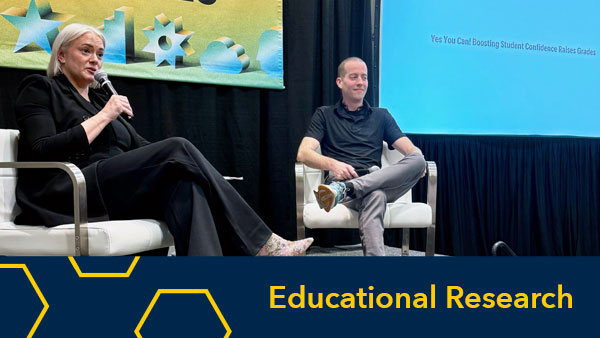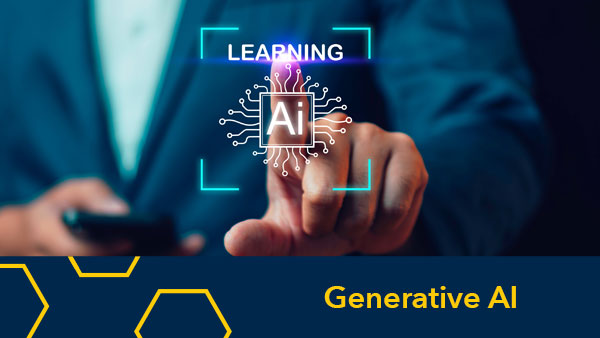This article was originally posted on 1/10/2017 on EvoLLLution
James DeVaney, Associate Vice Provost for Academic Innovation
@devaneygoblue
Tim McKay, Arthur F. Thurnau Professor of Physics, Astronomy and Education
@TimMcKayUM
Where should universities draw a line between collaboration and competition when it comes to student learning in an information age? We think perhaps this is the wrong question. Across higher education, student learning is a consensus goal: something we all want to increase, all the time, at every institution, not just our own. It is, for example, hard to imagine a university seeking competitive advantage by impeding the learning of students on another campus. So the real question is something more like this:
What mix of collaborative and competitive activity among institutions best helps us realize the shared goal of student learning?
To answer this question, let’s weigh the pros and cons of each. We’re going to focus on collaboration and competition among higher education institutions, rather than between institutions and commercial vendors. Those relations are important too, but probably a different topic.
What are the advantages of collaboration? To start, it’s the high moral ground. Here at the University of Michigan, we want our students to learn as much as possible, and would like to do this better than anyone else. But we can also advance our goals by collaborating and improving student learning at other institutions. Perhaps this point is obvious, but it’s central to understanding how colleges and universities behave. When we help one another improve learning, we all win. Universities inherently maintain a collaborative mindset.
Part of our comfort with collaboration is structural. Higher education is a huge, highly differentiated landscape. Yet, we would argue that we don’t fully take advantage of our scale or our unique institutional strengths. Each institution takes up only a small fraction of the possible education space—no one approaches monopoly status, even within a region. No one desires monopoly status. Our institutions are limited in size, so it’s just not feasible. In an environment like this, raw, unlimited competition makes no sense.
What are some potential drawbacks of collaboration? First, formal collaborations often seek exclusivity. This can be at odds with free and open participation. Second, mutually beneficial agreements don’t materialize without serious effort. We need to understand our different motivations in addressing a shared problem if we’re to create conditions for collaboration that benefit all involved. Finally, good collaborations thrive on creative input from all partners, but weak ones foster blind imitation. Think of all the consortia that all do the same thing just because that’s what everyone is doing. We see power in collaborations that identify the best ways to leverage our scale and help our unique strengths come to the surface; we see danger in those that inspire regression toward the mean.
Why compete? A collaborative mindset is characteristic of mission-driven institutions, but each also pursues individual influence. By investing in knowledge creation and dissemination, public engagement, and societal impact, institutions seek to influence each other and the world. We see this as the best form of competition—a mode that pushes every institution toward greater quality, deeper discovery, new standards of excellence. Our competitive spirit and our collaborative mindset provide complementary motivations. Indeed, one of the most effective ways to compete for influence in higher ed is through thoughtful collaboration.
This conversation about fostering student learning through collaboration and competition is emerging now for a good reason. Education in the information age is increasingly digitally mediated, producing increasingly rich records of what students are asked to do, how they do it, and what outcomes are produced. The existence and availability of this data has turned our campuses into living laboratories, enabling us to learn from the experience of every student. These data also provide new opportunities for action, especially important for personalization at scale.
Institutions are acting on this opportunity across the landscape of higher ed. Formal collaborations as diverse as the University Innovation Alliance, edX, and Unizin have all emerged over the last few years, each taking advantage of the opportunities education in the information age provides in different ways. Informal collaboration is vibrant as well, often through scholarly connections like the Society of Learning Analytics Research, but also connecting at the institutional level through meetings like Harvesting Academic Innovations for Learners (the HAIL Storm) about to take place at the University of Michigan.
To take one example further, the HAIL Storm will bring teams to Ann Arbor in January from more than 20 institutions representing many areas of our differentiated landscape. The conditions for collaboration are set: These institutions all share an interest in exploring new models for educational R&D. The problem space is vast and requires our collective attention. The participating institutions have vastly different perspectives and each offer new innovative models to strengthen our collective thinking. Together we seek to set new standards for excellence in educational R&D to increase student learning.
It is this collaborative mindset bolstered by competitive spirit that fuels academic innovation in an information age. The opportunities we can see and those around the corner call for the collective energy and talents of a huge and differentiated higher education landscape, aided, in execution if not in vision, by an array of commercial partners. By modeling partnerships that balance a collaborative mindset with competitive spirit, all in the interest of increasing student success, we expect to inspire new and more dynamic partnerships with commercial partners as well. We’re optimistic about our collective potential. But where is this all going? We think we’re making progress in a few important directions.
Together we are moving toward a networked global laboratory for learning: toward greater access to high-quality higher education and more inclusive environments to meet the changing needs of diverse learners. We are also developing improved models of educational R&D and accelerated adoption of tools that work.
The best collaborations are open, nimble and flexible. They allow institutions to learn from one another, while going their own way. In them, we will see teams of institutions pull ahead of their peers, setting new standards for all, drawing them along. The right mix of collaboration and competition will help educational R&D achieve its promise.


